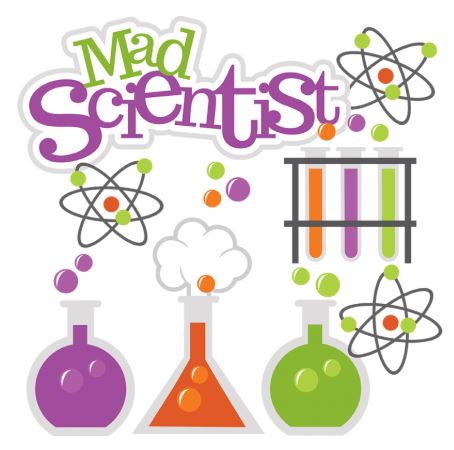You MUST have permission from your parent/guardian BEFORE conducting experiments!
PLEASE share your photos/videos with me!
Alum Crystals
This science experiment uses hot tap water and a kitchen space to grow crystals overnight. The crystals are non-toxic, but they aren't good to eat. This is one where adult supervision should be used!
Baking Soda Volcano
A chemical volcano made using baking soda and vinegar is a classic science experiment, appropriate for kids of all ages. You can make the cone of the volcano or can cause the lava to erupt from a bottle. I would suggest adult supervision and this being done outside!
Bouncing Ball
Polymer balls are a variation on the slime recipe. These instructions describe how to make the ball and then go on to explain how you can alter the recipe to change the characteristics of the ball. Learn how to make the ball clear or opaque and how to make it bounce higher.
Cabbage pH Paper
Make your own pH paper test strips from cabbage juice and then test the acidity of common household chemicals. Can you predict which chemicals are acids and which are bases?
Candy Chromatography
Examine the pigments in colored candies (or food coloring or marker ink) using a coffee filter and a saltwater solution. Compare dyes from different products and explore how color works.
Crystal Spikes
This is the quickest crystal project, plus it's easy and inexpensive. Evaporate a solution of Epsom salts on construction paper, which can give the crystals brilliant colors. The crystals develop as the paper dries, so you will get quicker results if you lay the paper out in the sun or in an area with good air circulation.
Egg in a Bottle
If you set a hard-boiled egg on top of an open glass bottle it just sits there, looking pretty. You can apply science to get the egg to fall into the bottle. See if you can figure out how to get the egg in the bottle before reading the instructions.
Ice Cream Experiment
Experiment with freezing point using salt and ice to lower the temperature of the ingredients to make your tasty treat. This is a safe experiment that you can eat!
Invisible Ink
Any of several safe household substances can be used to make invisible ink. Some of the inks are revealed by other chemicals while others require heat to reveal them. The safest heat source for heat-revealed inks is a light bulb. This project is best for kids age 8 and older.
Iron from Cereal
This experiment doesn't necessarily require cereal. All you need is any iron-fortified food and a magnet. Remember, iron in large amounts is toxic so you won't pull huge quantities out of food. The best way to see the iron is to use the magnet to stir the food, rinse it with water, then wipe it with a white paper towel or napkin to see the tiny black filings.
Lava Lamp Experiment
Experiment with density, gases, and color. This rechargeable 'lava lamp' uses non-toxic household ingredients to create colored globules that rise and fall in a bottle of liquid.
Make Flubber
Flubber is made from soluble fiber and water. It's a less-sticky sort of slime that is so safe you could eat it, but DON'T because it doesn't taste good! .
Make Your Own Paper
Learn about recycling and how paper is made by making your own decorative paper. This science experiment/craft project involves non-toxic materials and has a relatively low mess factor.
Mentos and Diet Soda Fountain
The mentos and soda fountain, on the other hand, is a project with a high mess factor. Have kids try this one outdoors. It works with regular or diet soda, but clean-up is much easier and less sticky if you use diet soda.
Milk Color Wheel Experiment
Experiment with detergents and learn about emulsifiers. This experiment uses milk, food coloring, and dishwashing detergent to make a swirling wheel of color. In addition to learning about chemistry, it gives you a chance to play with color (and your food).
Rock Candy
Sugar crystals do not grow overnight, so this project takes some time. However, it's a great way to learn about crystal-growing techniques and the rock candy result is edible.
Rubber Egg & Rubber Chicken Bones
The magic ingredient for this fun kid's chemistry project is vinegar. You can make chicken bones flexible as if they were made of rubber. If you soak a hard-boiled or raw egg in vinegar, the eggshell will dissolve and you'll be left with a rubbery egg. You can even bounce the egg like a ball.
Seven Layer Density Column
Make a density column with many liquid layers using common household liquids. This is an easy, fun and colorful science project that illustrates the concepts of density and miscibility.
Sharpie Tie-Dye
Decorate a T-shirt with "tie-dye" from a collection of permanent Sharpie pens. This is a fun project that illustrates diffusion and chromatography plus produces wearable art.
Slime Experiments
There are many recipes for slime, ranging from the kitchen ingredient variety to chemistry-lab slime. One of the best types of slime, at least in terms of gooey elasticity, is made from a combination of borax and school glue.
Water Fireworks
Experiment with color and miscibility by making water fireworks. These "fireworks" don't involve any fire. They simply resemble fireworks, if fireworks were underwater. This is a fun experiment involving oil, water and food coloring that is simple enough for anyone to do and produces interesting results.

